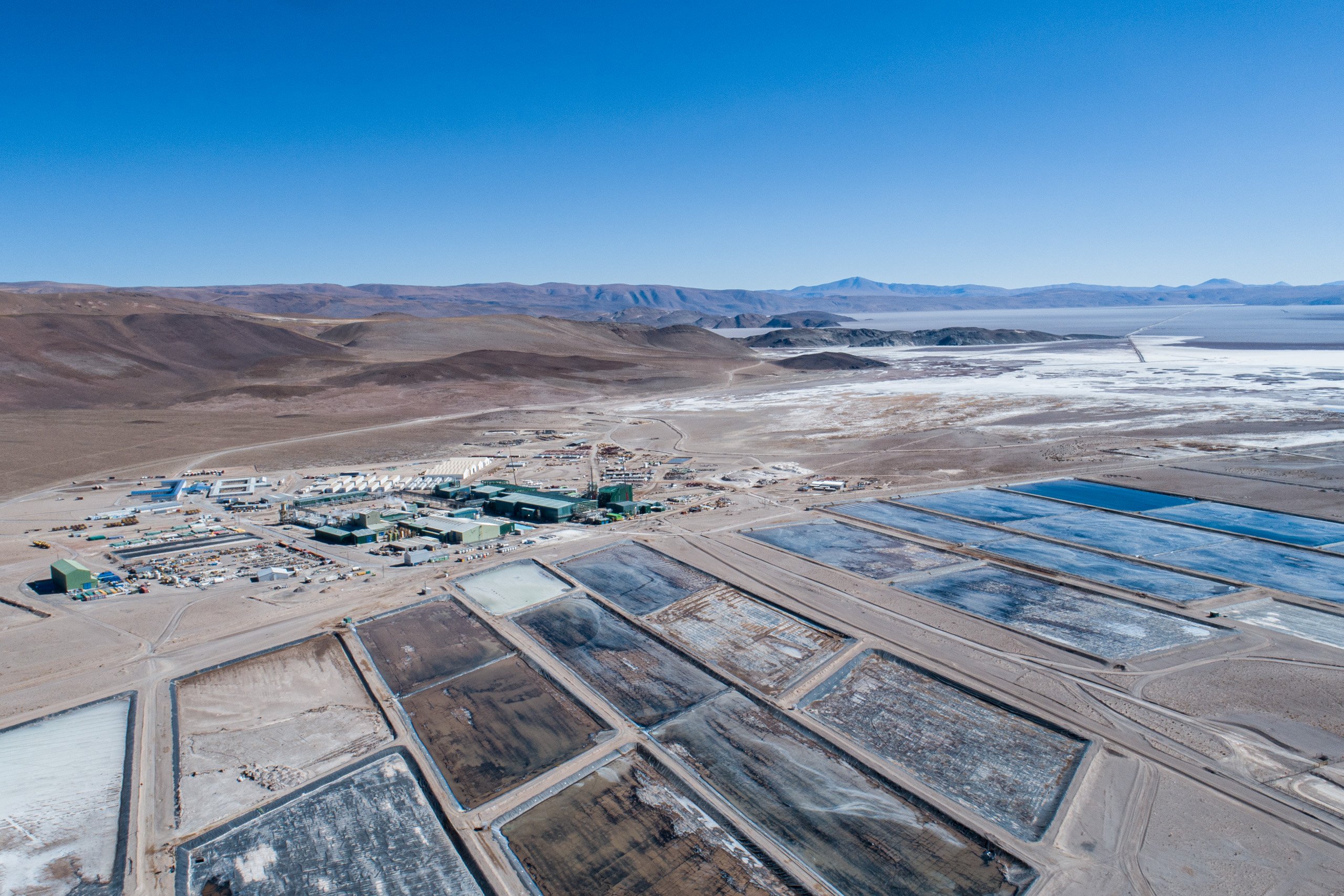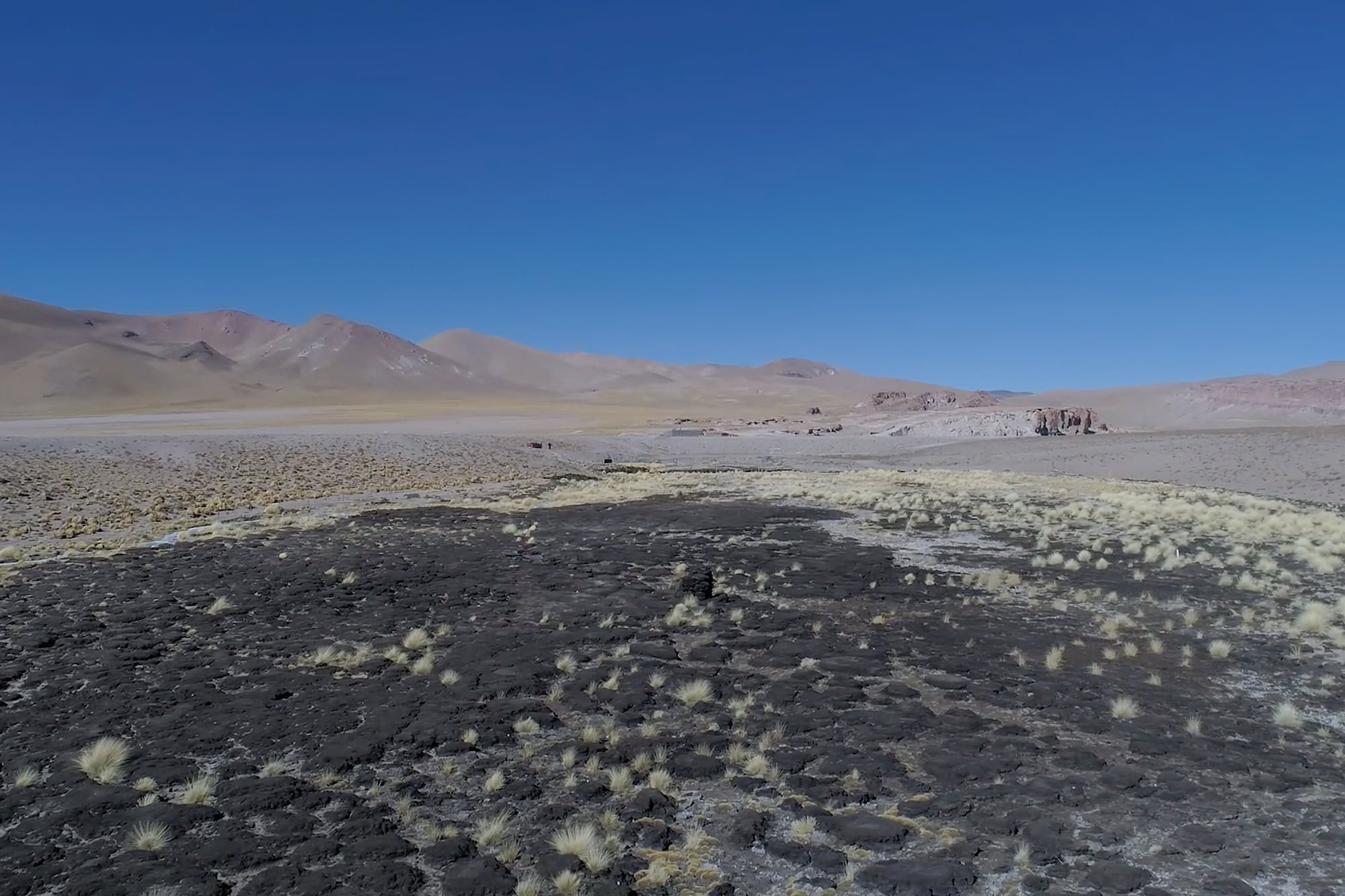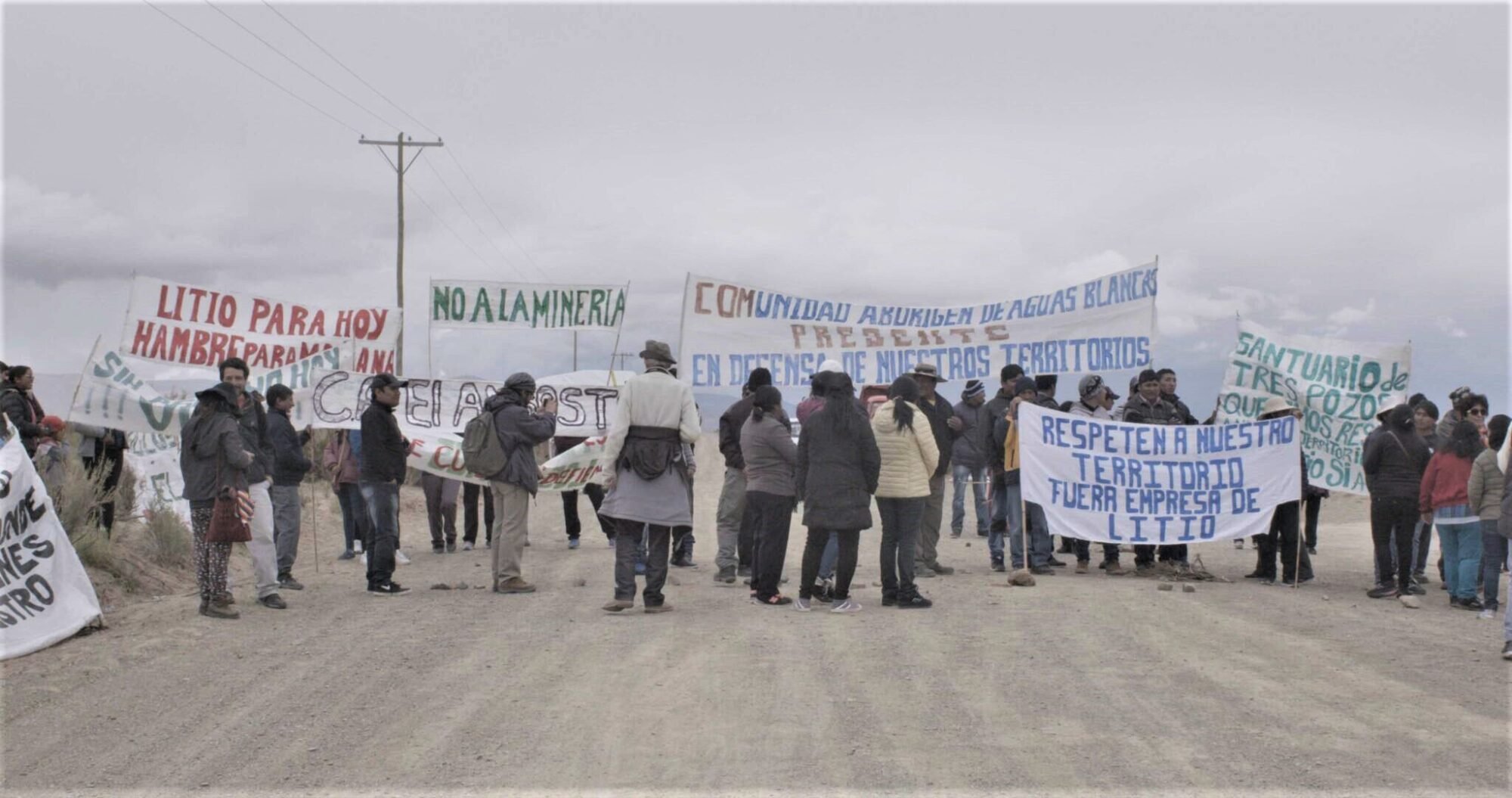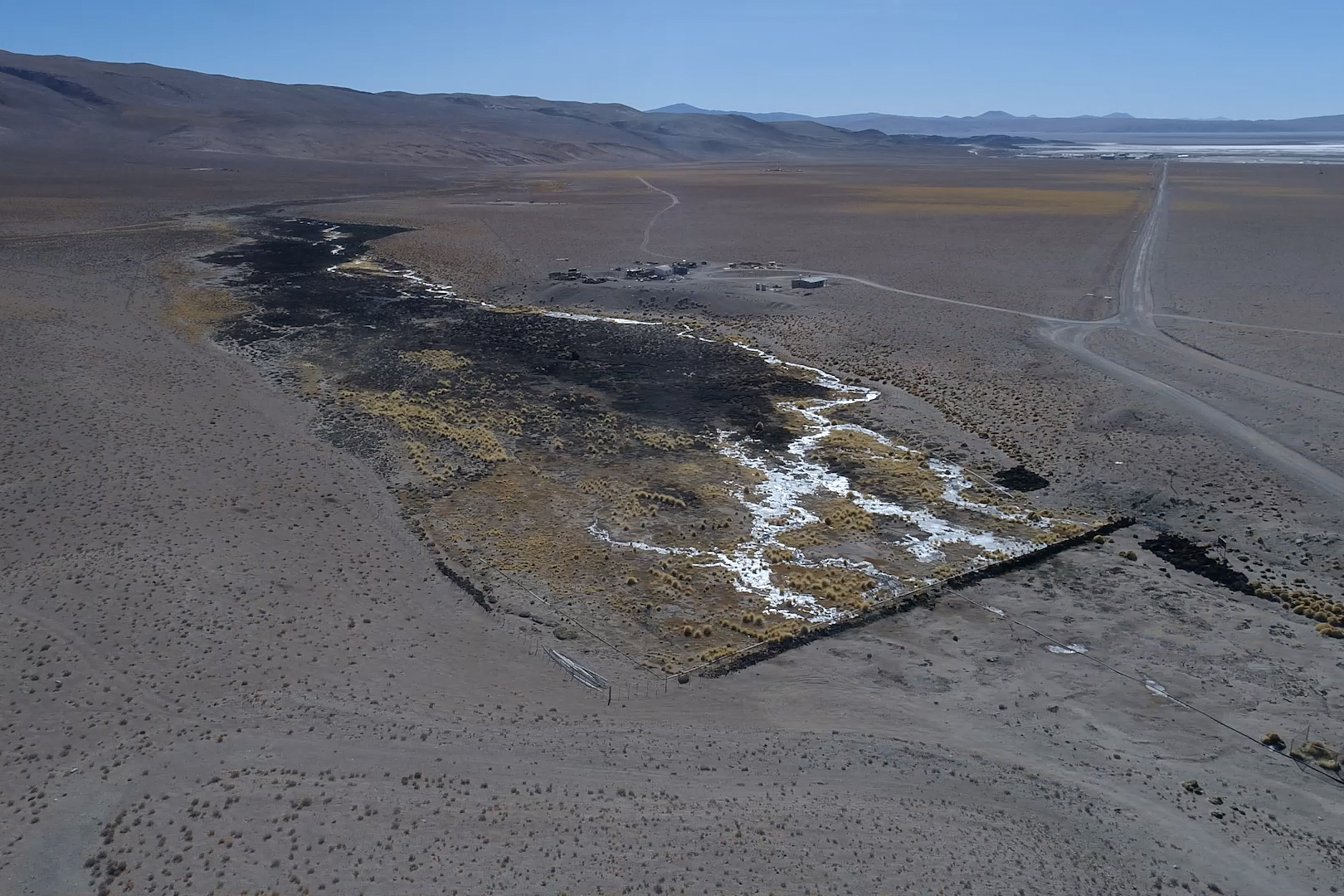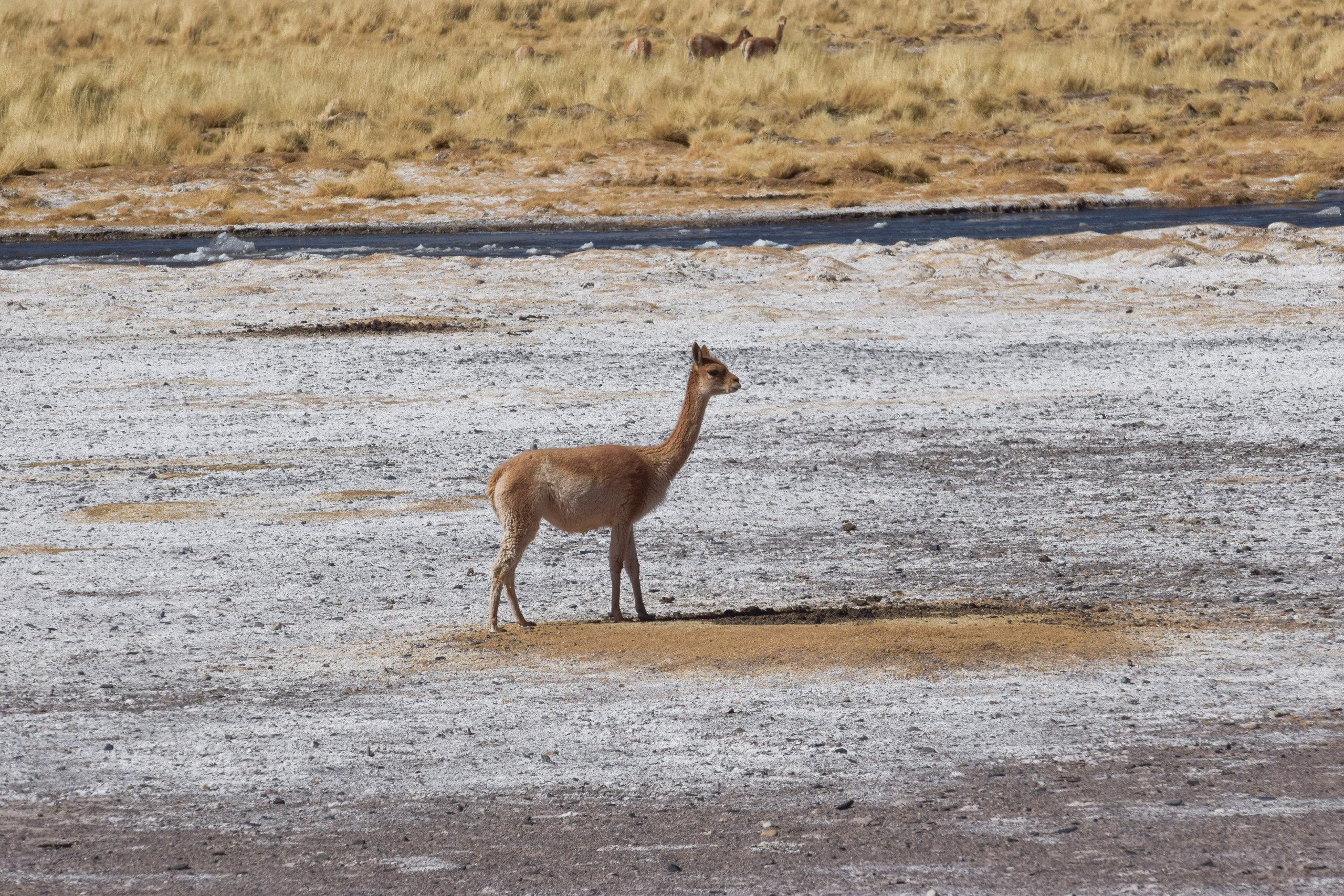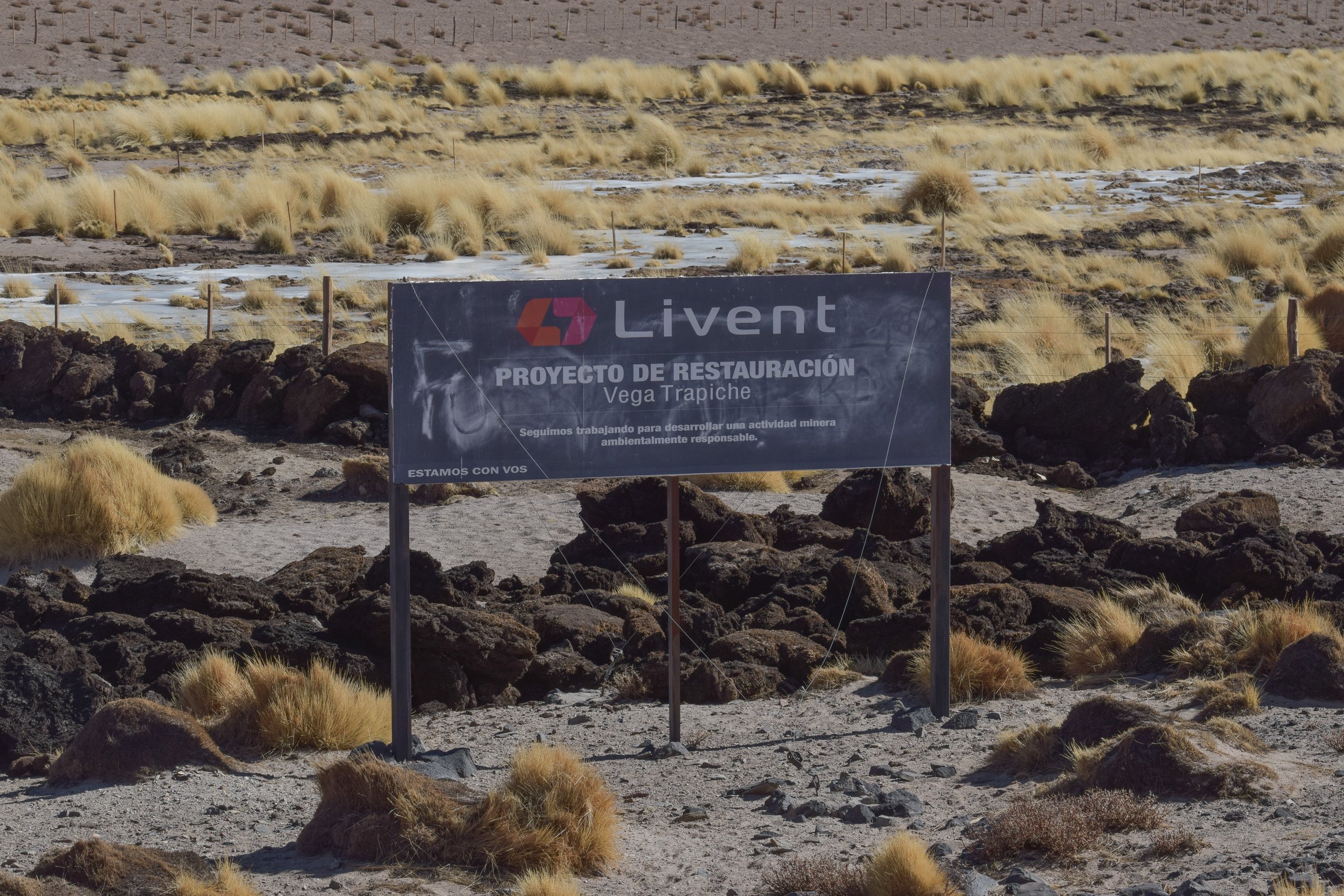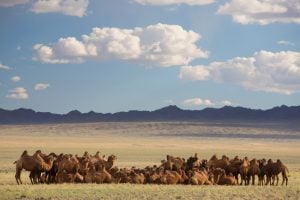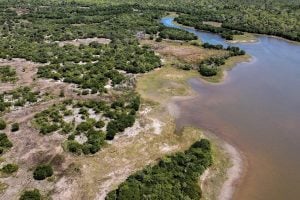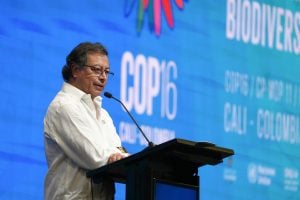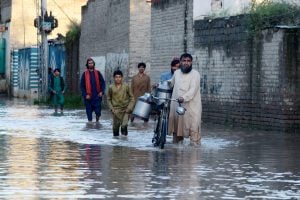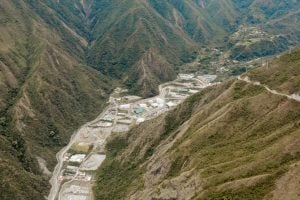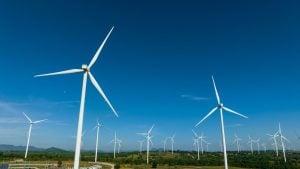Alfredo Morales bears on his face the toll of the relentless cold and searing sun that hangs almost year-round over Antofagasta de la Sierra, a town on the high plains of Catamarca province, northern Argentina. The 55-year-old, an activist with Atacameños del Altiplano, a local Indigenous organisation, is driving his truck out to the nearby Salar del Hombre Muerto salt flat. There, he wishes to show us the consequences of more than 25 years of lithium extraction by Livent, a mining company now known as Arcadium Lithium: the drying up of the Trapiche River, and the fading of the surrounding ecosystem.
A team from the Argentine investigative news outlet Ruido travelled with Morales to this expanse of desert, ringed by great mountains and volcanoes. The only sounds that broke the silence of this almost lunar-like landscape were the trucks of mining companies coming and going from the nearby lithium extraction plants. This is the site of Arcadium’s Fénix project, the oldest lithium mine in Argentina, which has operated in the Salar del Hombre Muerto since 1997.
As lithium projects multiply in Argentina, stirred by rising global demand, the marks left here by mining may offer a warning for the future over the industry’s environmental impact. Darkened patches of dead vegetation are the first thing that can be seen upon a dry plain where just a few years ago the Trapiche River used to flow. This stretch of parched land extends for around seven kilometres, where water once flowed and fed pastures, vicuñas, pumas, Andean cats and even three species of flamingos. These animals are no longer seen in the area.
Ruido’s trip to the Salar de Hombre Muerto was part of an investigation coordinated by the Latin American Center for Investigative Journalism (El CLIP), together with Dialogue Earth, Nómadas from Bolivia, CIPER from Chile, and master’s students from Columbia University in New York. Amid increasing interest in the mineral for its essential role in global energy transitions, this team set out to investigate the other side of lithium.
Together with Bolivia and Chile, Argentina forms part of the so-called “Lithium Triangle”, the area hosting 53% of the world’s identified lithium resources. Although most of the mining projects in the region are still in pre-exploitation stages, at sites that have been operating for a number of years, the environmental damage caused by lithium extraction is already visible, as this investigation witnessed.
In Argentina, it is the dried up plains beside the Trapiche River that have felt this the most, while in Chile, academic researchers recorded how areas of the Salar de Atacama most exposed to lithium mining have sunk by up to two centimetres in recent years due to groundwater depletion, driven by the mineral’s water-intensive process of extraction.
Atacameños del Altiplano is one of the Indigenous community groups that have organised to protect other rivers in northern Argentina from similar risks linked to lithium mining. A few months ago they won a victory in that battle: the Supreme Court of Catamarca ruled that lithium mining had damaged the river and halted the industry’s expansion close to another stream in the province, Los Patos, until it can be verified that it will not suffer the same fate as the Trapiche.
As he drives, Alfredo tells us of the group’s history of opposition to lithium projects. “At the beginning, the roadblocks [set by protestors to prevent access to mining sites] were due to labour issues, but we also saw that a lot of water was being consumed, that the valley was drying up,” he says. “We spoke to the manager, we made complaints, but nothing.”
He continues by telling us of the Condorí family, who used to live on the edge of the valley, raising sheep and more than 300 llamas. Now, he says, they have only eight llamas, and can no longer raise animals without the same access to water. “They are going to have to leave,” he laments.
For his wife, Elizabeth Mamani, also an Atacameños activist, “lithium means technological progress”, but also “death in the future, because we know that there is a lot of environmental disaster because of this exploitation, a lot of drought and losses. It makes economic sense for the population, but for me it means nothing but destruction.”
The Livent mine
In 2023, Argentina exported USD 835 million of lithium, representing 20.8% of the country’s mining exports, according to mining secretariat data shared with reporters. Over 40% of this lithium is sold to China, where it is used to produce the batteries that power electric cars, but also mobile phones and computers.
Arcadium Mining’s Fénix project at the Salar del Hombre Muerto is Argentina’s largest lithium mine. Last year, it generated 22,000 tonnes of lithium carbonate, almost half of the 50,000 tonnes produced in the country, according to government data. The other three mines currently producing lithium are Centenario Ratones in Salta province, and Cauchari-Olaroz and Olaroz in Jujuy province. A fifth, Sal de Oro, located between Catamarca and Salta, is about to begin production.
The Fenix project was originally managed by Livent, but the US-owned company merged in early 2024 with Australia’s Allkem to create Arcadium Lithium, which was itself bought out by British-Australian mining giant Rio Tinto this October. Rio Tinto is now set to rank as the world’s third largest lithium producer.
Argentina is the fourth largest lithium producer globally, behind Australia, Chile and China, but its reserve potential is even greater. Argentina has some 40 projects in preliminary stages that could reach production in the short term. Since President Javier Milei took office in December 2023, his government has sought to promote new legislation that motivates the disbursement of capital for mining projects through tax, customs and financial benefits that allow, for example, the liquidation of all dividends shortly after a project enters operation.
“Since Milei took over as president, there have been constant enquiries from mining companies because they perceived a change in the business climate. We are receiving calls from embassies, and also from the provinces, asking about lithium,” said a source at the country’s National Mining Secretariat.
Legal rulings on lithium
In March 2024, the Supreme Court of Catamarca ordered the provincial government to refrain from granting new permits for mining activity in the Los Patos stream area, until a “cumulative and comprehensive” environmental impact study has been carried out. One of the arguments cited in the court ruling is the negative impact mining has hadon the Trapiche valley. The case came following an environmental appeal filed in 2021 by Román Guitian, the leader of the Atacameños del Altiplano community.
This is the area where Arcadium intends to expand its lithium extraction, as part of the Sal de Vida project, just a few kilometres east of the Trapiche River. The company acquired the project when its first owner, Australian miner Galaxy Lithium, merged into Allkem, which later became part of Arcadium. The court requested that the study should cover “the landscape, the fauna and flora of the area, the climate and the environment in general, as well as the living conditions of the local inhabitants and the affected Indigenous community”.
During the visit to the area, our journalists were able to observe how the dried-up section of the Trapiche River used to reach the Arcadium plant, where the water would enter the mining facilities to be used in the lithium extraction process. Now, the company appears to have built a barrier near the point where the river dries up, which stores the incoming water. From there, it is transported to the plant through a pipeline.
Arcadium’s predecessor, Livent, has accepted that there have been changes to the ecosystem of the Salar del Hombre Muerto, but says these are reversible. “One of the most important conclusions drawn from our modelling work in the Trapiche aquifer is that the effects on water resources are reversible and that the estimated timeframe for recovery to pre-development conditions is 10 years after the cessation of mining,” Livent said in its sustainability report from 2022, when it oversaw the facility.
The company also argued that they provide the only economic activity in a largely unpopulated area. “Less than 20 people live within a 60-kilometre radius of the facility, and the nearest town is almost two hours’ drive away. Unlike other salt flats, there are no other industries in the Salar de Hombre Muerto, and the harsh environment generated by the altitude prevents commercial agriculture and livestock farming,” it claimed.
During the trip, reporters noted other changes in the course of the Trapiche, since in some of these upstream stretches, the riverbed had been lined with plastic, not allowing the water to run off into the ground or towards the banks, presumably to achieve a higher flow.
“It is a very important alteration to the ecosystem and to the possibility of fish or algal life, which are essential for it to function,” said biologist Cecilia Estrabou, director of the Centre for Ecology and Renewable Natural Resources of the National University of Córdoba. “But this can also lead to a significant production of microplastics, which the world is fighting very hard against. Putting it in a river – from which animals and plants surely drink – is a detrimental alteration for the food webs, on the one hand, and for the use of water by living organisms,” she added.
Arcadium did not respond to questions regarding the plastic linings in the river. An official spokesperson for the Ministry of Mining of Catamarca did, however, and said that these were “channelling works designed to minimise percolation and evaporation of water, optimising its collection and storage in the Trapiche dam reservoir, which allows for a more efficient use of water resources.”
Los Patos, a risk area
Several kilometres east of the lithium extraction plant, herds of vicuñas and flamingos drink from Los Patos stream, still wide and majestic despite the visible traces of a once much larger watercourse. On the sides, seven containers protect the boreholes and pumps that draw water from the basin, extending many metres below. There are no signs to tell which of the nearby mining companies they belong to. One of the big questions is, as with the Trapiche River, whether this stream could also dry up.
“I would like them to record the flow of Los Patos so that there is a record of what it will be like tomorrow,” says the activist Morales. “Our community has opposed the damage to the river.” He points to the large number of birds and wild animals here as a cause for concern as mining advances.
The Environment and Natural Resources Foundation (FARN), an Argentine NGO and one of the organisations promoting the legal cases to defend the salt flat’s ecosystems, has claimed that in the Salar del Hombre Muerto, more specifically in the area of Los Patos, the government of Catamarca did not carry out “an environmental impact assessment that contemplates the cumulative effects of these initiatives”.
“Local communities are affected by lithium mining in their territory and environment, as well as in their basic rights such as access to information, participation, free, prior and informed consent, and access to justice,” said Leandro Gómez, coordinator of the investments and rights programme of FARN’s environmental policy area.
Alfredo Morales is not sure if the ruling that prohibits – for now – the expansion of mining projects into the Los Patos River is a triumph. He says he distrusts the judiciary, and all powerful actors. Nor is his wife, Elizabeth Mamani, a member of Atacameños, optimistic.
“The court ruling is a strong advantage that sets an important precedent in the struggle to defend water, but at the same time I feel that with this justice system, and the way we are, they are going to continually fence off our territories,” said Mamani.
No further details on the publication of the study requested by the court have yet emerged. The spokesperson of the Catamarca government did not comment on the process.
The impacts discussion
FARN argues that the extraction of brines for lithium mining can cause an imbalance in the hydrology of the salar: freshwater reserves become salinised and affect the availability and quality of freshwater in the basin. Once this happens, the water leaves the system and is never recovered with the same conditions and characteristics, the organisation reports.
In their studies in other similar ecosystems, FARN has found that “the impacts of climatic and ecological crises are already being felt in high altitude wetlands, increasing the pressures that naturally characterise them, such as their extreme aridity, high evaporation and solar radiation rates, and the permanent natural water deficit.”
In Livent’s 2022 sustainability report – the most recent that is publicly available, and the only resource sent by the company following requests for comment on this article – the mining company claims the opposite. That is, that the effects of lithium mining are reversible and that the company uses very little of the water that flows in nearby streams: just 2%, it claims. They reported that they work with external specialists to ensure that “the extraction of water and brine is carried out at a rate that maintains the natural balance of this ecosystem”, and that this is monitored by the provincial government.
The company said that together with the EcoConciencia Foundation, an environmental NGO that works on social and environmental conflicts, and residents of the region, they are carrying out environmental tasks such as replanting trees, improving irrigation systems, and monitoring and tracking species in the area.
Rodolfo Tarraubella, president of EcoConciencia, said they only began working with Livent in 2021, organising meetings and collaborating to transplant 25,000 plants. “From then on we only helped a little. The company provided its own people to monitor and follow up.” He clarified that the organisation does not receive money from Arcadium.
Economic alternatives
The roughly 2,000 inhabitants of Antofagasta largely live in conditions worse than those in the mining camps run by companies in the salar. They have no access to the natural gas network, suffer almost daily power cuts, running only on generators, and water is scarce in the summer months. Mayor Mario Cusipuma, who took office at the beginning of 2024, says he has focused his early efforts on introducing a new municipal tax code, with which he wants companies to pay more local taxes and to see the “spillover” of mining resources.
In its 2022 sustainability report, Livent reported revenues of USD 813.2 million and a gross profit of USD 366.7 million, excluding discounts for taxes, depreciation and debt repayments. The company says it has invested USD 2.8 million in the community in Catamarca, in programmes focused on health, nutrition, education, training, quality of life, climate action and local development.
At the beginning of 2024, there were 2,968 workers hired by mining companies in lithium projects in the provinces of Salta, Catamarca and Jujuy, according to records of the Ministry of Economy accessed for this investigation. This represents less than 1.5% of the 184,000 public employees in the three provinces.
While Arcadium, through its predecessor Livent, is one of the pioneers in South American lithium mining, more recently, a new wave of investment has come from China. Juliana González Jáuregui, a researcher focused on Chinese investment in Latin America, explains: “The role played by China in the Lithium Triangle is increasingly relevant, especially in Argentina, and this has to do with national legislation, which is more liberal compared to Chile and Bolivia.”
Cusipuma, the mayor of Antofagasta, is determined that local people should keep a share of the lithium exploitation. “We are looking to regulate fees and change the paradigm,” Cusipuma said. The municipality is now working to improve infrastructure, electricity and drinking water utilities. They also want to bring natural gas to the city and pave the Route 43 highway that runs towards the province of Salta. The mayor said that mining companies use this route because most of the waste from lithium extraction is transported in trucks to treatment plants in Salta, adding that the same route could encourage tourism.
Activist Mamani also wants to bring the struggles over lithium closer to tourists. One of her ventures is a handicraft business: “I sell these products not only for the money, but also to explain to [visitors] what is happening with lithium, because they don’t know, and they are grateful to hear about it. I feel very helpless about the situation, but I wouldn’t leave Antofagasta. There are possibilities for growth, for valuing the land, for tourism, for great sustainability for my children and for the population, which have not yet been realised. Antofagasta is a thousand wonders in one.”
As Mamani highlights, Antofagasta offers incomparable natural beauty but is difficult to access due to poor infrastructure and a lack of services for tourists, such as accommodation and restaurants. For now, apart from a few intrepid visitors, the beauty of this part of the Catamarca seems to be reserved for lithium mining.
This story is part of an investigative series by Ruido, Nómadas, CIPER Chile, Dialogue Earth and students of the Columbia Journalism School, coordinated by the Latin American Center for Investigative Journalism (El CLIP)
